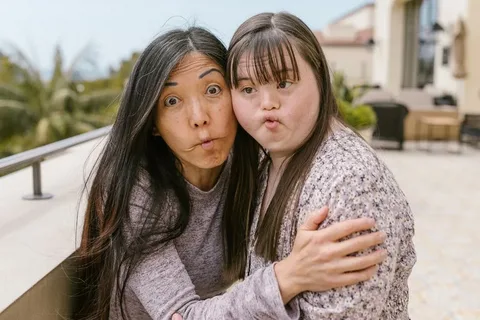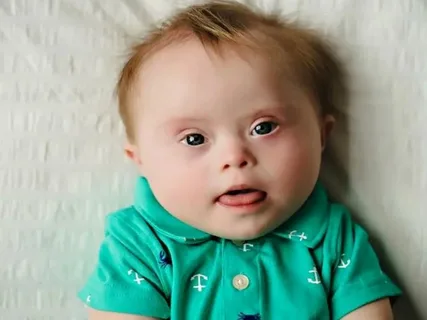Down Syndrome
Genetic disorder Down syndrome is a lifelong condition that begins before birth. It happens when a baby is born with an extra chromosome in their body’s cells.
Usually, people have 46 chromosomes in every cell. But a person with Down Syndrome has 47 chromosomes, because of an extra copy of chromosome number 21. This condition is also known as Trisomy 21.
This extra genetic material affects the child’s development in different ways. They may look a little different, have some health problems, and learn things more slowly. But with love, care, and support, people with Down Syndrome can live healthy, joyful, and successful lives.
Why Is It Called a Genetic Disorder?
The term “genetic disorder” is used because this condition is related to changes in genes and chromosomes — things we inherit from our parents. However, Genetic disorder Down syndrome is not passed down in most cases. It usually happens by chance during the formation of cells in the womb.
It is important to understand that this is not anyone’s fault — not the mother’s, not the father’s. It’s a natural condition that can happen to any baby in any part of the world.
What Does Genetic Disorder Down Syndrome Look Like?
Children and adults with Genetic disorder Down syndrome often have some shared physical traits:
- A flat facial profile
- Almond-shaped, upward-slanting eyes
- Small ears and nose
- A single crease across the palm
- Shorter height
- Looser joints and low muscle tone
They may also experience delays in learning, speaking, or moving, but with therapy and patience, they can make great progress. Many develop their own interests and passions — from sports to music to art.
How Does Down Syndrome Happen?
Every human body is made up of trillions of cells. Inside each cell are chromosomes that carry instructions for how our body should grow and function.
- Normally, a baby gets 23 chromosomes from the mother and 23 from the father, making 46 total chromosomes.
- In Down Syndrome, there is an extra copy of chromosome 21, making it 47 chromosomes in total.
This happens by chance during the baby’s development in the womb. It is not caused by anything the parents did wrong. It can happen to anyone, anywhere in the world.
Different Types of Genetic disorder Down syndrome
There are three types of Down Syndrome:
1. Trisomy 21 (about 95% of cases)
- Every cell in the body has three copies of chromosome 21.
2. Translocation Down Syndrome (about 4%)
- Part of chromosome 21 breaks off and attaches to another chromosome.
3. Mosaic Down Syndrome (about 1%)
- Some cells have 46 chromosomes, and some have 47. This can lead to milder symptoms.
All three types cause similar challenges, but the severity can vary from person to person.
How to Identify It: Common Physical and Learning Traits
Every person with Down Syndrome is unique. However, there are some common features that may be seen:
Physical Features:
- A flat face with almond-shaped, upward-slanting eyes
- A short neck
- Small hands and feet
- A single crease across the palm
- Looser joints and weaker muscles (called low muscle tone)
- Shorter height compared to other children of the same age
Learning and Behavior Traits:
- Slower learning and speech development
- Difficulty in reading, writing, or solving problems
- Very loving, friendly, and caring nature
- Can show great creativity and joy
Children with Down Syndrome learn at their own pace, and with special help, they can achieve a lot in life.

Health Conditions Linked with Genetic disorder Down syndrome
People with Down Syndrome may also face certain health problems, including:
- Heart problems (some babies are born with holes in the heart)
- Hearing loss or vision problems
- Frequent colds and infections
- Sleep apnea (breathing problems during sleep)
- Thyroid disorders
- Digestive issues
But don’t worry — with early medical care, regular check-ups, and proper treatment, many of these problems can be managed successfully.
How Doctors Diagnose Genetic disorder Down syndrome
Genetic disorder Down syndrome can be diagnosed:
Before Birth (Prenatal Tests):
- Screening tests like blood tests and ultrasounds during pregnancy
- Diagnostic tests such as:
- Amniocentesis (testing amniotic fluid)
- Chorionic Villus Sampling (CVS)
After Birth:
- Doctors look at physical features
- Confirm with a karyotype test, which checks the baby’s chromosomes
The earlier the diagnosis, the better the chances of giving the child the right support and care.
Can Genetic disorder Down syndrome Be Treated or Cured?
There is no cure for Down Syndrome because it is a genetic condition. However, with early therapy, medical help, and education, children and adults with Down Syndrome can:
- Learn to speak clearly with speech therapy
- Improve muscle strength with physical therapy
- Learn daily life skills through occupational therapy
- Attend special schools or inclusive schools
- Build friendships, hobbies, and even have jobs
Down Syndrome may bring challenges, but it also brings great joy, courage, and strength
How to Support People with Down Syndrome
Everyone can help make the world a better place for people with Genetic disorder Down syndrome :
- Be kind, patient, and understanding
- Speak clearly and give them time to respond
- Don’t tease or bully
- Help them feel included in school, games, and social events
- Appreciate their talents — some love music, painting, or dancing
- Encourage them to try new things and be confident
Importance of Awareness and Inclusion
Spreading awareness about Genetic disorder Down syndrome helps:
- Remove fear, shame, or false beliefs
- Encourage people to treat others with respect
- Help families know they are not alone
- Ensure early treatment and education
- Create inclusive schools, playgrounds, and workplaces
World Genetic disorder Down syndrome Day – March 21
People all over the world wear mismatched socks on this day to show that it’s okay to be different — and being different is beautiful.
Real Stories of Strength and Success
Here are some amazing people with Genetic disorder Down syndrome who inspire the world:
- Sujeet Desai – A world-class musician who plays 7 instruments
- Madeline Stuart – An Australian model with Down Syndrome
- Karen Gaffney – A swimmer and public speaker
- In India, many schools and NGOs now support inclusive education
These individuals show us that having Down Syndrome does not limit dreams — it simply means the journey may be a little different.
Final Thoughts: A Kinder World for All
Genetic disorder Down syndrome is not something to be afraid of. It is a part of human diversity. People with Down Syndrome may need extra help, but they also give extra love, extra smiles, and extra inspiration.
Let’s promise to build a world where everyone is treated fairly, included equally, and celebrated for who they are.
FAQs
Q1: Is Down Syndrome a disease?
No. It is a genetic condition present from birth.
Q2: Can children with Down Syndrome go to regular schools?
Yes. Many attend inclusive schools with support from special educators.
Q3: Can they live independent lives?
Yes. With training and support, many adults with Down Syndrome work, travel, and live independently.
Q4: Can it be prevented?
No, it happens naturally. But support and awareness can help people with Down Syndrome live fulfilling lives.
Q5: Why do people wear colorful socks on World Down Syndrome Day?
To celebrate diversity and show support for people with Down Syndrome.
Q6: Can people with Genetic Disorder Down Syndrome get married?
Yes. Many adults with Down syndrome form meaningful relationships and some choose to get married. Like all relationships, it depends on emotional connection, maturity, and personal choice.
Q7: Is Down syndrome more common in boys or girls?
Down syndrome can affect both boys and girls equally. There is no significant difference in how often it occurs between genders.
Q8: What is the life expectancy of someone with Genetic Disorder Down Syndrome?
With proper medical care and support, the average life expectancy has improved greatly. Many people with Down syndrome now live into their 60s or beyond.
Q9: Can people with Down syndrome have jobs?
Yes! Many individuals with Down syndrome work in offices, schools, restaurants, and more. With job training and support, they can be successful and independent employees.
Q10: Can Down syndrome be detected during pregnancy?
Yes. There are prenatal screening and diagnostic tests (like amniocentesis and CVS) that can detect Down syndrome before birth.
Q11: Do all people with Genetic Disorder Down Syndrome have the same abilities?
No. Like everyone else, people with Down syndrome have their own personalities, talents, and challenges. Some may need more support, others may be very independent.
Q12: Is Down syndrome becoming more common?
Due to advanced maternal age in some pregnancies, there has been a slight increase in cases, but overall, Down syndrome remains a rare condition — about 1 in every 700 births worldwide.
Q13: Can a person with Down syndrome go to college?
Yes. Many universities now offer special programs for students with intellectual disabilities, including those with Down syndrome. These programs teach life skills, job readiness, and even academics.
Q14: Do people with Down syndrome understand emotions?
Yes. They are often very emotionally aware, empathetic, and kind. They feel joy, sadness, love, and frustration just like anyone else — and often express emotions openly and honestly.
Q15: How can I teach children to respect people with Down syndrome?
Start by teaching kindness, inclusion, and empathy. Use books, videos, and real-life examples to show that different doesn’t mean less. Encourage questions and give clear, simple answers.




